When Will Fiber in My Area Be Available?
Table of Contents
If you’ve been searching for the best internet in your area, you’ve likely heard about fiber internet. With blazing-fast speeds, superior reliability, and lower latency than traditional cable or DSL connections, fiber internet represents the gold standard of home internet service.
But despite its growing popularity, fiber internet isn’t universally available yet, leaving many wondering when they’ll finally get access to this superior technology. So when searching for “fiber in my area," there are some things to consider.
What Makes Fiber Internet Better Than Other Options?
Before speaking to availability, let’s understand why fiber in my area is such a sought-after service. Fiber-optic internet uses thin strands of glass or plastic to transmit data via light signals [1], offering several advantages over traditional copper-based connections:
- Dramatically faster speeds: Fiber internet typically delivers speeds from 300 Mbps to 5 Gbps—far exceeding what cable or DSL can offer.
- Symmetrical upload and download: Unlike cable internet, fiber provides equal upload and download speeds, ideal for video conferencing, cloud backups, and online gaming.
- Greater reliability: Fiber cables are less susceptible to weather conditions and electrical interference than copper wires.
- Future-proof technology: As internet demands grow, fiber infrastructure can accommodate increasing bandwidth needs without major overhauls.
With our increasingly connected homes, fiber internet’s performance makes it the clear choice when comparing internet providers.
Why Isn’t Fiber Internet Available Everywhere?
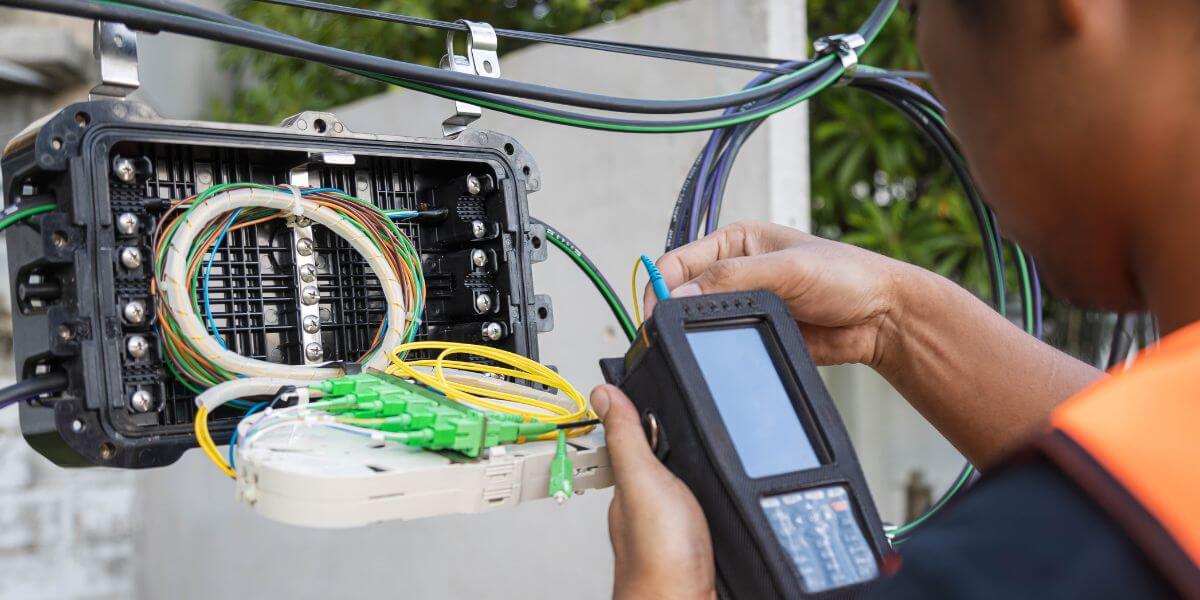
Is there fiber in my area?
So what’s holding back widespread fiber deployment? The challenge isn’t technological. It’s practical. Building fiber networks requires significant infrastructure investment, and several factors determine when fiber internet will reach your neighborhood.
Geographic Challenges
To bring fiber to your area, internet service providers (ISPs) must physically install fiber-optic lines either on utility poles or underground. This process becomes considerably more difficult in areas with challenging terrain, such as mountainous regions or extremely rural locations with sparse population.
Some geographic areas present unique installation challenges. In regions where utility poles aren’t suitable for fiber lines or where ground conditions make traditional trenching difficult, providers may need to find alternative installation methods. Innovative techniques like microtrenching—which creates narrow, shallow trenches for fiber cables [2]—can sometimes overcome these obstacles at lower cost and with less disruption.
Financial Considerations
According to the U.S. Department of Transportation, laying fiber costs approximately $27,000 per mile on average [3]. This significant investment makes it difficult for providers to justify expansion into areas with low population density, as there simply aren’t enough potential customers to recoup costs in a reasonable timeframe.
Fortunately, many state and local governments recognize that reliable, high-speed internet is becoming an essential utility. Government initiatives, such as the 2021 Infrastructure Investment and Jobs Act [4], have allocated substantial funding to expand fiber infrastructure, particularly focused on addressing the digital divide that leaves rural communities behind.
Regulatory and Permitting Processes
The timeline for fiber deployment varies significantly between communities, with local government approval processes playing a critical role. While some local leaders prioritize rapid fiber deployment, the permitting process can be lengthy in other areas, delaying projects even when providers are ready to begin installation.
Since installing fiber often involves digging into streets and crossing private property, addressing public concerns about construction disruption can further delay the approval process.
How to Check if Fiber Internet is Available in Your Area
If you’re eager to know if fiber internet has reached your neighborhood yet, here are some practical steps to take:
- Check your address with multiple providers: Visit the websites of fiber internet providers and enter your street address to check service availability.
- Sign up for notifications: Most fiber providers offer notification services that will alert you when fiber becomes available at your address. This keeps you informed without having to repeatedly check availability.
- Contact your local government: Local officials can often provide information about planned infrastructure projects, including fiber internet expansion in your community.
- Talk to neighbors: In some cases, fiber may be available on nearby streets but not yet connected to your specific address. Neighbors might have information about local installation timelines.
When comparing internet plans and providers, availability should be your first consideration. After all, even the best internet provider can’t help if they don’t service your location.
What Does the Fiber Installation Process Look Like?
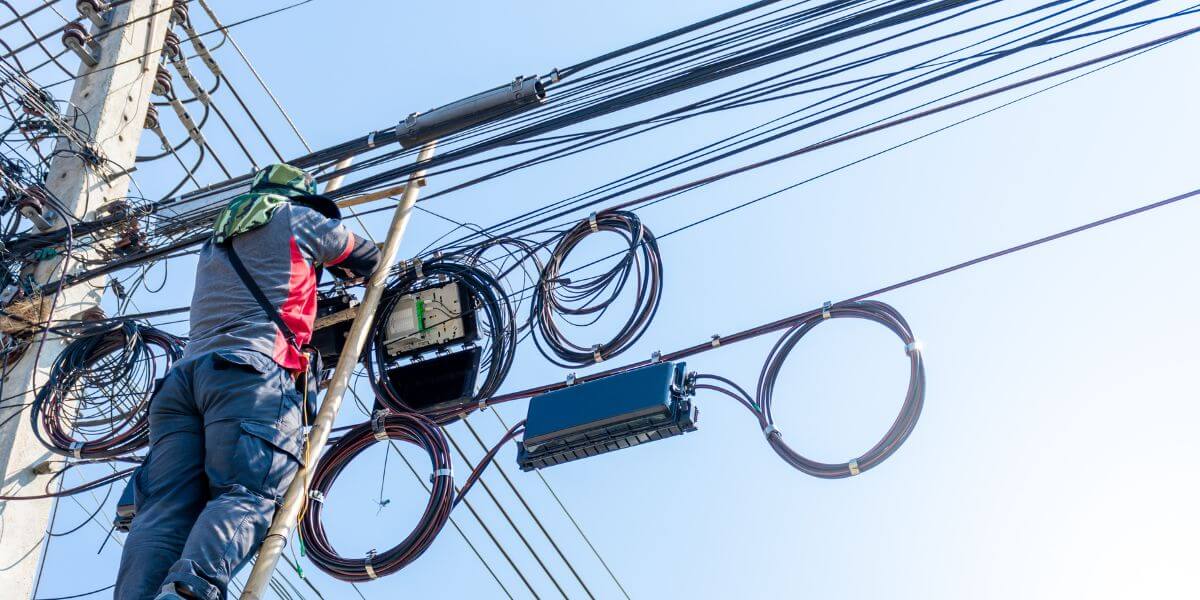
Installation considerations
When fiber finally comes to your street, the installation typically follows these steps:
- Surveys and utility marking: Crews gather information about the neighborhood and mark existing utility lines before any digging begins.
- Fiber installation: Technicians install cables either on utility poles or in underground conduits. Weather conditions and traffic considerations can impact the timeline for this phase.
- Cleanup: After installation, crews fill in any holes and remove equipment or materials from the installation site.
Once the neighborhood infrastructure is in place, the final step is connecting fiber from the street to individual homes. This process might require one or two service appointments, depending on your property’s layout. Technicians will install an optical network terminal (ONT) at your home [5], connect your fiber router, and verify you’re receiving the speeds you’ve selected.
How Long Will It Take for Fiber to Reach My Area?
While everyone wants a precise timeline, the honest answer is that it depends on multiple factors:
- Current infrastructure: Areas with existing conduit or suitable utility poles will see faster deployment.
- Population density: Urban and suburban areas typically receive fiber before rural regions.
- Local government support: Communities with proactive local governments that streamline permitting tend to get fiber sooner.
- Provider priorities: Each internet provider has its own expansion strategy and prioritization formula.
The arrival of fiber ultimately depends on where you live, which providers operate in your region, and how proactive your local government is about infrastructure development. But there’s good reason for optimism. Demand for fiber internet continues to grow, and both private companies and government initiatives are accelerating deployment nationwide.
Alternatives While You Wait for Fiber
If fiber internet isn’t yet available in your area, several alternatives can provide reasonable performance:
- Cable internet: Offers good download speeds (though typically with much slower uploads).
- Fixed wireless: Delivers broadband internet via radio signals from a nearby tower.
- 5G home internet: Where available, can provide fiber-like speeds without requiring physical lines.
- Satellite internet: Available virtually anywhere with a clear view of the sky, though often with higher latency.
When comparing internet prices across these options, remember that the cheapest plan isn’t always the best value. Consider the speed, reliability, and data caps of each service in relation to its cost.
How Fidium Fiber is Expanding Access

Getting fiber to all
Fidium Fiber is actively working to bridge the digital divide by expanding our high-speed fiber network to more communities. We’re investing in infrastructure development and working closely with local governments to accelerate deployment, particularly in underserved areas.
Our expansion prioritizes:
- Communities with limited high-speed internet options
- Areas where infrastructure can be efficiently upgraded
- Regions showing strong demand for fiber services
The Future of Fiber in My Area
Fiber internet availability is rapidly evolving. Federal and state initiatives are allocating unprecedented funding to expand broadband infrastructure, with a particular focus on fiber technology. The Broadband Equity, Access, and Deployment (BEAD) Program alone is directing $42.5 billion toward expanding high-speed internet access in underserved communities [6].
As these investments take shape, we expect to see accelerated fiber deployment across the country over the next several years. For many Americans wondering “when will fiber be available in my area," the wait may be shorter than expected.
Don’t wait to discover if the best internet providers have reached your neighborhood. Enter your ZIP code below to check if Fidium Fiber is available at your address. If we’re already there, you can compare internet plans and find the perfect speed for your household needs. If we haven’t reached you yet, sign up for notifications so you’ll be first to know when fiber arrives in your area.
Sources
[1] Lenovo. “What are fiber optic Internet connections?"
[2] GCP. “Microtrenching: A new and improved way to install fiber optic cable."
[4] U.S. Department of Transportation. “H.R.3684 – Infrastructure Investment and Jobs Act."
[5] Monolithic Power Systems. “Optical Network Terminal (ONT) Units."
[6] NTIA. “Broadband Equity Access and Deployment Program."


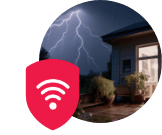

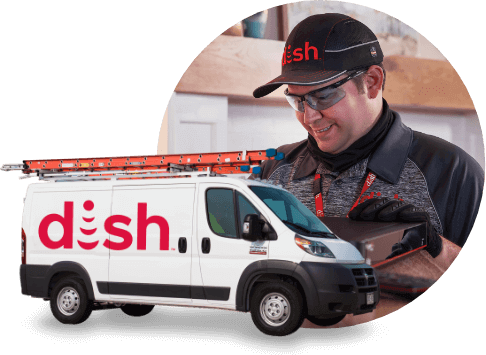
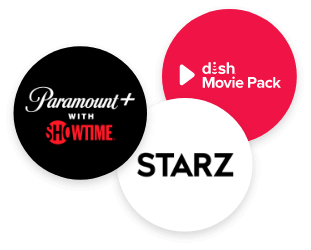

 Call
Call 

 Access Your Account
Access Your Account